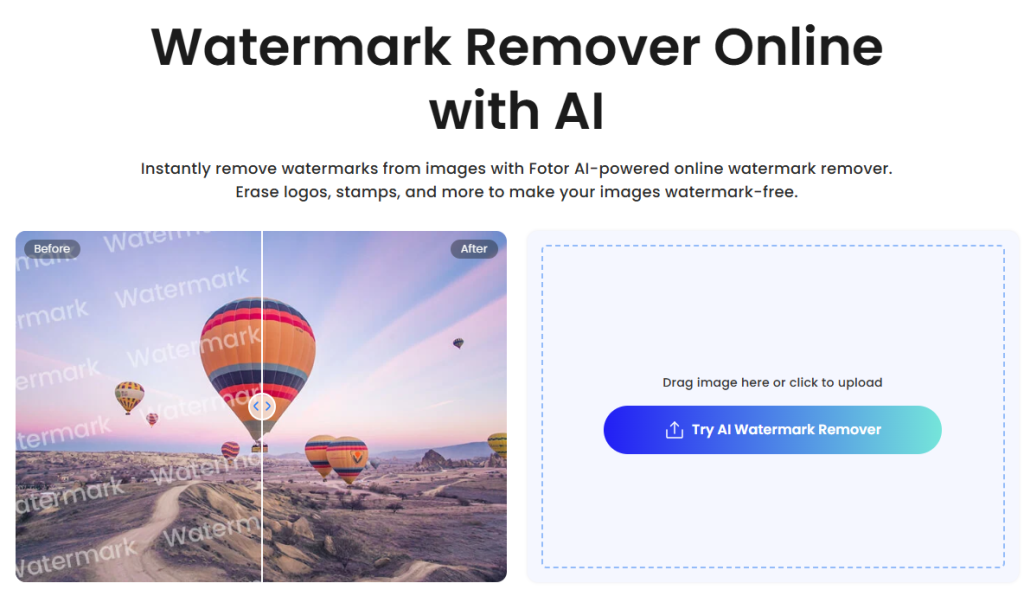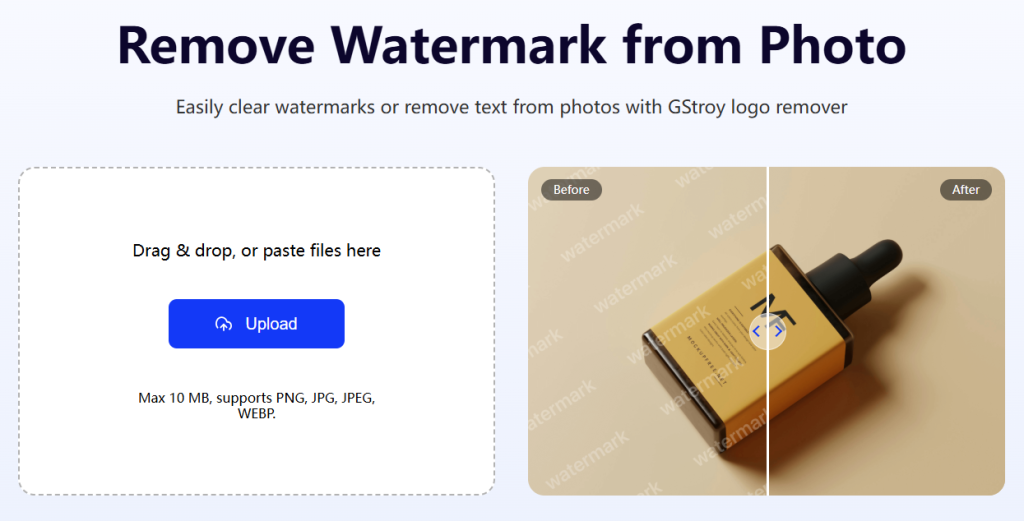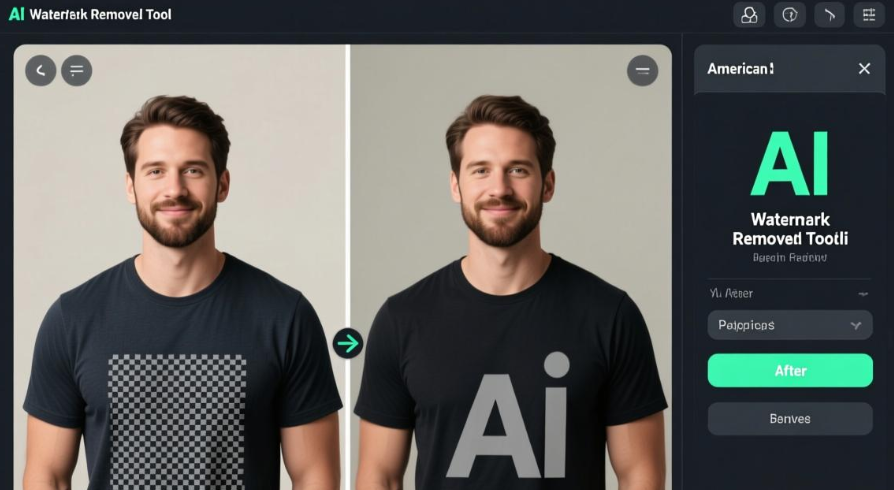Last Updated on November 13, 2025 by gaojie
Watermarks have always been a double-edged sword. On one side, they protect creators, photographers, and businesses by clearly showing ownership of a piece of content. On the other side, they often get in the way when you’re simply trying to reuse your own work or make a video look clean for social media.
I’ve been creating digital content for years, and I’ve lost count of the times I downloaded a file only to realize it had a giant transparent logo running across the middle. Or maybe I exported my own project with a test watermark and forgot to save the original. And of course, anyone active on TikTok knows the frustration of that bouncing watermark when you try to share the clip somewhere else.
Naturally, watermark remover tools have become more and more popular. One of the names you’ll often see is the Fotor watermark remover. Fotor is a well-known photo editing platform, and its watermark remover is one of the features that draws people in. But is it actually good enough for creators today?
In this article, I’ll walk you through how Fotor performs, where it shines, where it struggles, and why tools like GStory.ai are the next step forward—especially if you care about video and social media content.
Why Do People Want to Remove Watermarks in the First Place?
Before diving into the tools, let’s pause and think about the “why.” If watermarks are meant to protect content, isn’t removing them wrong?
The truth is, there are plenty of legitimate reasons. For example:
- You uploaded your own design to test a watermark, and now you just want the clean version back.
- You bought stock photos but need to remove the watermark after downloading the licensed version.
- You’re re-editing a project and the original files were lost, so the only copy left has a watermark.
- You made a TikTok video and want to repurpose it on Instagram Reels without the bouncing TikTok logo.
In all these cases, you’re not stealing anyone’s work—you’re simply reclaiming or repurposing your own. That’s an important distinction to keep in mind.
Exploring the Role of Fotor AI in Photo Editing
When we talk about Fotor, it’s more than just a watermark remover. The Fotor AI watermark remover powers many of its editing features, from retouching portraits to adjusting backgrounds automatically. This makes the platform appealing for beginners who want quick results without advanced design skills. However, its AI focus remains mostly on images, which is why it doesn’t extend to video watermark removal.
Fotor AI works best for tasks like smoothing backgrounds, removing simple logos, or brightening and enhancing photos with minimal effort. If you are mainly dealing with still images and basic edits, Fotor AI can save a lot of time. But if your content involves moving images or complex multi-layered graphics, the platform’s limitations become apparent.
First Look at Fotor Watermark Remover
Fotor’s watermark remover is straightforward: upload a photo, highlight the area with the watermark, and let the AI fill in the background.
Here’s what stands out:
- Ease of use: The tool runs in a web browser, no downloads required.
- Beginner-friendly interface: No design skills are needed.
- Decent results for simple watermarks: Small text or corner logos usually disappear cleanly.
However, there are limitations:
- The free version only exports in lower quality.
- Larger or semi-transparent watermarks often leave blurry traces.
- Video watermark removal is not supported.
For casual use, especially photos, Fotor is fine. For heavier or more complex editing, you’ll need a more robust solution.

Testing Fotor in Real Situations
I tested Fotor with different watermark scenarios:
- Plain text watermark on a white background – Almost perfect removal.
- Logo watermark on textured background – AI created a slight blur, making the removal noticeable upon close inspection.
- Large semi-transparent watermark – The tool reduced visibility but left faint outlines.
- TikTok video watermark – Not supported at all.
Takeaway: Fotor is great for light photo edits, but it struggles with complex backgrounds or video content.
Can You Really Free Remove Watermark from Video in 2025?
A common search today is whether you can free remove watermark from video without losing quality. Many creators want a way to edit out watermark cleanly, but free tools often leave artifacts or limit file length.
This is where GStory.ai shines. It offers a clean, automated workflow for removing watermarks from TikTok, Instagram, and other social media videos. The result is smooth, professional-looking content without the ghosting or blur seen in many free alternatives.
Can You Improve Fotor’s Results?
If you’re sticking with Fotor, some tricks help:
- Highlight watermark areas carefully.
- Repeat the removal process for faint traces.
- Export at the highest resolution.
- Use background repair or manual touch-up tools for smoother results.
Even with these steps, Fotor can’t handle video watermarks or extremely complex images as effectively as GStory.ai.
Why Video Watermarks Matter More in 2025
Most people used to focus on photo watermarks. Today, video dominates social media. Platforms like TikTok, Instagram Reels, and YouTube Shorts embed platform logos directly into videos.
These watermarks aren’t just distracting—they can affect engagement when sharing content across multiple platforms. Fotor can’t process videos, so if your workflow involves video, it simply doesn’t meet modern creator needs.

Enter GStory.ai: A Modern Alternative
Unlike Fotor, GStory.ai is built for today’s content creators. Key features include:
- TikTok watermark removal – Quickly remove logos without degrading video quality.
- Video editing online – No software downloads or complicated setups.
- Photo enhancement – Sharpen and brighten images alongside videos.
- Free to start – Core features accessible without payment.
Essentially, GStory.ai extends the convenience of photo editing to video content, saving time and improving quality for creators.
My Hands-On Comparison: Fotor vs. GStory.ai
Here’s what I found:
- Photo watermark removal – Fotor works well for simple edits; GStory.ai is equally capable and adds optional enhancement.
- Video watermark removal – Fotor fails completely; GStory.ai removes watermarks cleanly and maintains quality.
- Workflow efficiency – GStory.ai combines multiple tasks in one platform, reducing the need for multiple apps.
For casual photo edits, Fotor is fine. For creators handling videos, GStory.ai is the clear winner.
The Legal and Ethical Side of Watermark Removal
It’s critical to remember: removing watermarks on content you do not own can be illegal. Only remove watermarks when:
- It’s your own content.
- You have permission from the owner.
- You’re using it for personal or non-commercial purposes.
Respect copyright, and these tools become powerful productivity aids rather than legal risks.
Who Should Use Fotor, and Who Should Use GStory.ai?
- Fotor: Ideal for casual users, bloggers, or beginners who mostly edit photos.
- GStory.ai: Built for social media creators, marketers, or anyone working with videos and multi-platform content.
Essentially, Fotor handles simple image cleanup, while GStory.ai addresses modern multi-format needs.
Final Thoughts
In 2025, photo-only watermark removers are no longer enough. Fotor Watermark Remover remains useful for basic image editing, but GStory.ai offers a complete, video-capable solution. It handles TikTok watermarks, improves image and video quality, and streamlines workflow for modern content creators.
Personally, I still use Fotor for quick photo edits, but when producing video content or social media posts, GStory.ai has become indispensable.
